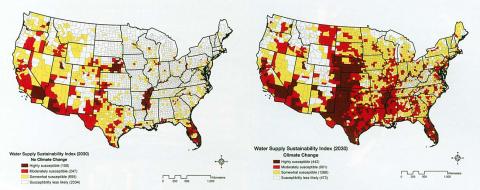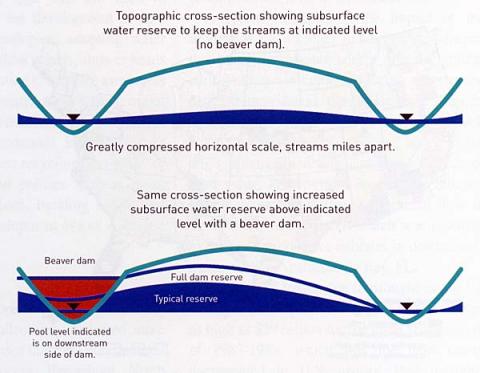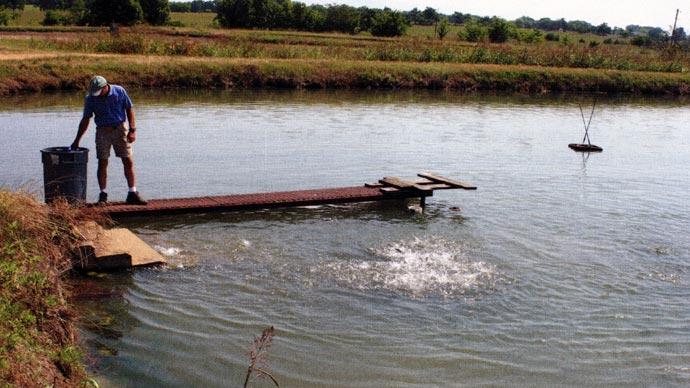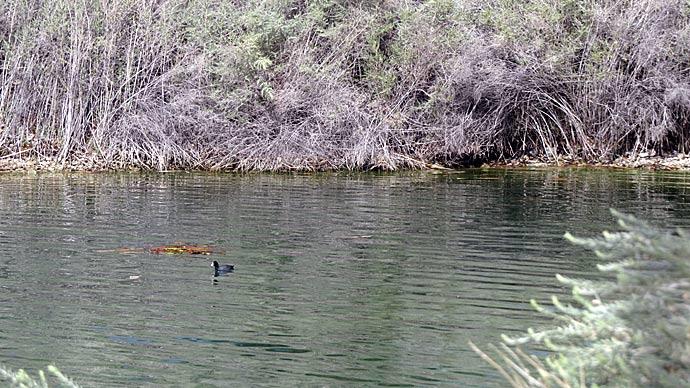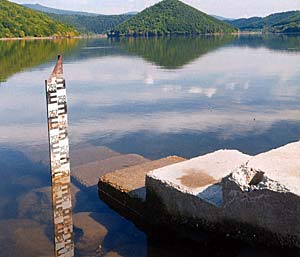
Freshwater comprises only 1% of all available water on Earth, and is the limiting factor for all terrestrial (non- marine) organisms and is essential for human survival. Water shortages are likely to become the major environmental and natural resource crisis of the 21st century, because consumption of freshwater supplies is at long-term unsustainable rates.
Factors That Complicate Solutions to Freshwater Scarcity
Humans have ready access to approximately 14% of the planet's freshwater and we have used approximately 50% of the available freshwater runoff, and by 2025 the number could reach 70%. One estimate suggests that if per capita consumption everywhere reached the level of more developed countries, we could be using 90% of available water each year.
How Did We Get Here?
Part of the answer is advanced technology to harvest more water. Another part of the problem will be population growth and shifts in population density such as to the coastal zone, increasing demand over supply. The US population is estimated to be nearly 350 million by 2025 and 392 million by 2050. These population growth trends are why the curve of freshwater demand is expected to cross the curve of supply in the future where enough communities will experience freshwater scarcity in the aggregate to be characterized as a widespread phenomenon.
In the 20th century, global population increased 300 percent while demand for freshwater increased 600 percent. Part of this is due to the industrial age and advancements in agriculture (including spray irrigation), both resulting in greater amounts of water used per capita. In the U.S, thermo-electric power production accounted for 48% (cooling water), irrigation 34%, and public supply 11% and the remaining made up by activities such as mining, industrial use, and aquaculture (USGS, 2005).
The average person in an industrialized country uses 132-211 gallons of water per day (the variation is due to standard of living components such as dishwasher, clothes washer, watering your lawn, etc.), which can be ten times more than the average person in developing countries, who use 16-40 gallons per day. Whereas water consumption by someone in arid-African developing countries has been estimated to be as low as 264 gallons/ person/year (which reflects a bush or nomadic life style)—see www.worldwater.org.

The U.S. Geological Survey estimated in 2000, that about 408 billion gallons of freshwater per day were withdrawn for all uses with a per person daily use of 1,430 gallons. This is a decline of about 12% in the average per capita average from 1990, when the per capita average use averaged nearly 1,620 gallons per day per person. During the same decade, the United States experienced a population increase of about 33 million. Total withdrawals have increased annually from 1950 to 1980 but have leveled off and varied less than 3 percent since 1985. This is good news due largely to increased efficiency in use. How far this can go is unknown, as is its impact on sectors of the economy (agricultural exports overseas). Allowing the price of water to float with supply and demand will help head off water shortages until increased water prices exceed what the public are willing to pay.
Peter Gleick, a noted author on freshwater resources, has reported that if each American today still used 1,940 gallons per day (as they did in 1975), population growth would have caused the U.S. to use an additional 165 billion gallons per day, which is equal to more than 12 new Colorado Rivers—or enough water for everyone in California, New York, Florida, Texas, Illinois, and Michigan. The reality is that we never could have supplied that much more water without destroying our remaining rivers, lakes, aquifers, and aquatic ecosystems.
A U.S. family of 4 pays on average $2.00 per 1000 gallons for municipal drinking water, which is approximately $500 per year. Industry currently pays about $6.00 per 1000 gallons. Both of these costs in a decade could double or triple due to increased demand and reduced supply. Many regions depend on groundwater to meet increasing water demands. Some regions in the U.S. have seen ground water levels drop as much as 300 to 900 feet over the past 50 years and with no future pumping, full recharge is likely to take centuries to millennia.
In the future, the U.S. will still need to continue to expedite the development of new low water use technologies: adopting water efficient toilets, waterless urinals, shower heads and appliances; education to increase awareness and change wasteful water use practices; use of native plants, low water landscapes and efficient irrigation systems; economic incentives such as pricing and rebates; recycling and reuse of existing supplies; and policies such as water conservation regulations, building codes, and the planning and development of low water use communities.
Droughts
Droughts have been defined as natural hazards that have collectively impacted more people in North America than any other natural hazard. Droughts occur throughout North America, and in any given year, at least one region will experience drought conditions.
The impacts of droughts are not just rainfall shortages and crop losses but include impacts on society, jobs, the economy, and the environment. For example, in 1998, Florida suffered from a drought along with the states of Oklahoma and Texas. In Florida, drought- induced fires burned over 475,000 acres and cost $500M in damages. In the late 1980s and early 1990s, the U.S. West Coast experienced a six-year drought, causing Californians to take aggressive water conservation measures. Even the typically humid northeastern U.S. experienced a 5-year drought in the 1960s that drained reservoirs in New York City down to 25% of capacity. Should these past several year cycles of drought lengthen by only a year or two, then one might expect some localities to reach a critical level of freshwater scarcity.
A recent example of the impact of the drought is Lake Lanier in Cumming, Georgia, the major freshwater source for the greater metropolitan Atlanta, which experienced extreme drawdowns during the epic drought of 2007-08. Atlanta received strong pushback from the governors of adjoining states in the city's attempt to obtain additional sources of river water. The city also hoped to be relieved of maintaining an agreed-to minimal flow in the Chattahoochee River, which was essential to maintain productive fisheries in downstream estuarine-like Apalachicola Bay, FL.
The cost of losses due to drought in the US averages $6-8 billion every year, but can range as high as $39 billion for the three year drought of 1987-1989, which was the most costly documented in U.S. history. Past droughts east of the U.S. High Plains in the 1980's have caused critical freshwater shortages impacting barge traffic during low river flows on the Mississippi River and its tributaries.
Predicted Water Supply Sustainability Index (WSSI)
Tetra Tech in 2010 performed an analysis for the Natural Resources Defense Council, which combined water demand projections based on current growth trends with renewable water supply projections based on a number of climate models. The first map has been prepared to illustrate the predicted Water Supply Sustainability Index for 2030 without an adjustment for the impact of Climate Change on freshwater supplies. The second map has been prepared to illustrate the significant impact that climate change will have on the sustainability of water supplies for the year 2030.
In the second map, the warmer air increases plant transpiration and evaporation of moisture from the soils, lowering the water table, and plants die, leaving bare soils, then the sun heats up the bare soils, which gives off more heat to the atmosphere and more moisture is lost until we have a persistent draught. Now when rainfall does occur, we have greater surface runoff and flooding.
Major Consequences of Freshwater Scarcity
Nearly all forms of energy production (e.g., tar sands, biofuels, and petroleum cracking) require copious supplies of freshwater. Increased energy demands will compete with all other uses of freshwater whereby energy, freshwater, food, and fiber (e.g., cotton and timber) will become more expensive with negative influence on economic development, and maintenance of species and ecosystems.
For example, production of one gallon of ethanol produced from corn requires 2,000 gallons of water.
Unaffordable water and energy costs impact every nation's economy, subsequently preventing them from being able to import goods and services that they need, disrupting global trade and producing a global economic quagmire.
Future continued depletion of inland and ground water supplies will negate many of the Federal, State, and NGO environmental regulatory gains (NEPA, CWA, Endangered Species Act, ...etc.) of the last 50 years, including large conservation efforts (i.e., Ducks Unlimited).
There is an urgent need to begin developing advanced technologies capable of desalinating oceanic seawater in large volumes for coastal cities at lower energy costs, to achieve comparable costs to municipal drinking water today, because by 2025, over 75% of all Americans are expected to live in coastal counties. This approach we have proposed to Congress for funding (see Desalination Challenge at www.sigmaxi.org).
But What Can BassResource Readers Do?
There has been a failure of communication regarding the emerging widespread issue of freshwater scarcity. Some have not missed the message, like the large corporations associated with bottled water and individuals like T. Boone Pickens who have been buying up vast tracts of land that is above key underground aquifers. They have been studying water rights in certain states where the owner of the land owns the water below. Water is not a human or environmental right, under current US water policy and laws. Some day water stocks may be considered "Blue Chip" stocks. In approximately 20 years water, energy and security will be directly linked to economic growth, stability and development.
Why an emerging crisis is apparent is that the time required for putting in place federal and municipal funded infrastructure to develop new water sources will require several decades. The average time required to build a large Public Works Dam in the US has been on the average about 17 years (from appropriation to a full reservoir), even though a new dam had not been built since the early 1980s (US Army Corps of Engineers).
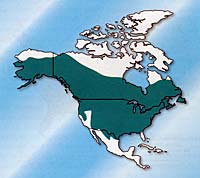
Make Like a Beaver and Build More Ponds & Lakes.
The Beaver (Castor candensis) is the first and finest water resources manager and the only animal to develop, protect and conserve water resources. Beavers spend their lifetimes nullifying the "ditching effect" on water tables caused by deepening river and stream channels. They reduce channel scouring and stream bank erosion, provide erosion mitigation and reduction of sediment loading in streams and rivers. They develop new wetlands, and even increase biodiversity including creating a better environment for fish and waterfowl. They provide a more stable water supply for wildlife, and vegetation. They directly increase ground water recharge and ground water table elevation, creating more cold-water springs charging rivers and lakes; increases land water retention time, since subsurface flow is slower than stream and river flow (See watershed figure).
Beavers also create flood mitigation due to increased ground water holding capacity. Beaver dams dampen stream flow rate variations and improve stream charge during drought cycles. Humankind has impacted the beavers major food source...the aspen. We learned from Edwin D. Michael in his book "A Valley Called Canaan (1885-2002)" that to get a solid stand of beautiful Aspen trees like in the photo, you have to have a beaver take down a single tree and then from existing roots you will get dense tree growth, whereas a single tree will only maintain itself as a single tree. An aspen tree stand is the largest living single organism on Earth.
To reduce future water shortages, we need to make like the beaver and build more lakes and ponds and manage watersheds and surface runoff in such a manner to provide aquatic ecosystems the same above benefits that the beaver did when it roamed North America. We need to read Tim Matson's (1991) book and the SCS handbook on "Ponds for Water Supply and Recreation" (1971) and figure out how to and where to fit more ponds and lakes on our property to reduce the future impact of water scarcity on the environment, and our life style.
References & Suggested Reading:
Matson, Tim. 1991. Earth Ponds: The Country Pond Maker's Guide to Building, Maintenance and Restoration. Second Edition, Countryman Press. Woodstock, Vermont. 150p.
Postel, S. and B. Richer. 2003. Rivers for Life: Managing Water and People for Nature. Island Press. 253p.
Pearce, F. 2006. When the Rivers Run Dry: Water-The Defining Crisis of the Twenty-first Century. Beacon Press. Boston. 324p.
Reisner, M. 1993. Cadillac Desert: The American West and Its Disappearing Water. Penguin Books, NY582p.
Tetra Tech Report. 2010. Natural Resources Defense Council, "Evaluating Sustainability of Projected Water Demands under Future Climate Change Scenarios." Roy, et al.
U.S.G.S. 2005. USGS Water Resources of the United States, www.water.usgs.gov.
Reprinted with permission from Pond Boss Magazine

